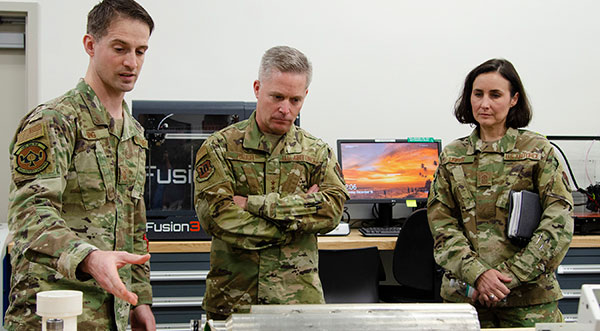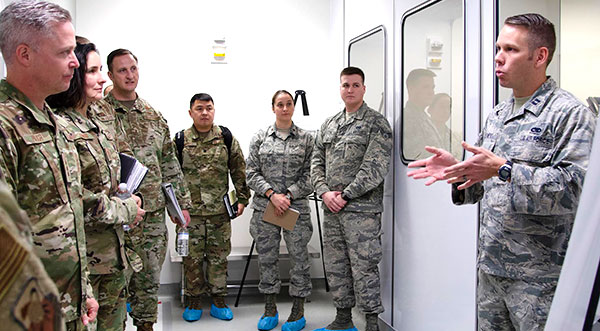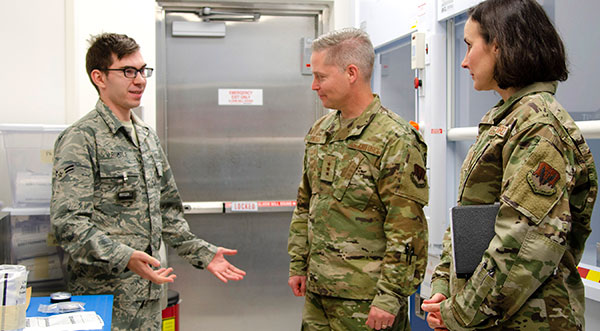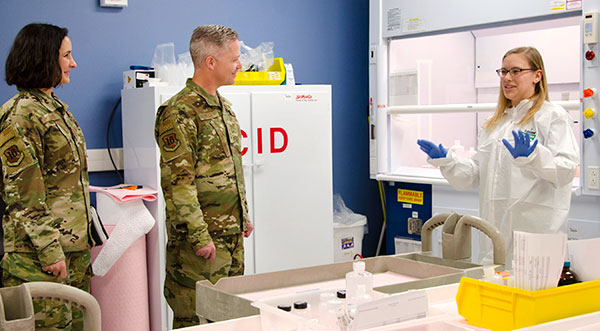New 16th Air Forces Cyber Commander Gets Up-Close Look at How Nuclear Treaty Monitoring Center Plays Critical Role
By Susan A. Romano, AFTAC Public Affairs // January 9, 2020
Lt. Gen. Timothy Haugh toured Air Force Technical Applications Center operations floor

BREVARD COUNTY • PATRICK AIR FORCE BASE, FLORIDA – The new 16th Air Forces Cyber commander visited the Air Force Technical Applications Center last month to get an up-close look at how the nuclear treaty monitoring center plays a critical role in the Numbered Air Force’s overarching intelligence, surveillance, reconnaissance, cyber and electronic warfare mission.
Lt. Gen. Timothy Haugh, accompanied by 16th AF Command Chief Master Sgt. Summer Leifer, met with various subject matter experts who execute AFTAC’s global objectives using its 3,600+ sensors positioned underground, underwater, in the atmosphere and in space to monitor nuclear treaty compliance.
The two senior leaders toured the technical operations floor, radiochemistry lab, clean room, innovation lab, and one of the newest additions to the center’s organizational structure, the AFTAC Digital Underground.
Haugh and Leifer met with a team of eight enlisted personnel known as Team Banana, who described AFTAC’s pilot initiative for in-house agile software development and how they test out methods of user-centered design and continuous delivery of operational software to mission users in order to deliver capability at the speed of relevance.
“Basically what we’re doing is upgrading legacy software platforms and building modernized web applications for our customers by leveraging already-existing software libraries,” said Senior Airman Thomas Anastasio.
“Our in-house application works by taking wonky machine-readable text and turning it into human-comprehendible information. It increases accuracy and makes it a whole lot easier for our scientists and mission partners to access the data.”
When asked how the team came up with the name Banana, Senior Airman Dalton McIntire smiled and said, “It actually started as a joke, kind of a play on words for us to follow in Apple’s innovative footsteps. We even came up with a funny logo, and when we briefed it to our leadership, they loved the idea so we ran with it.”

During their rounds, the general and the chief presented coins to a number of AFTAC’s superior performers. One of the recipients was Tech. Sgt. Jaime Benites, noncommissioned officer in charge of AFTAC’s Development Operations Lab. “I’m very honored to be coined on behalf of all my teammates,” he said.
“We would not be successful without every member of our team’s hard work over the past few months. Every person in our group has been going above and beyond to deliver capabilities to our users’ hands, and it really means a lot to have our efforts recognized in a positive way by NAF leadership.”
At the end of the visit, Haugh held a Town Hall meeting at the base theater to discuss his vision for the newly-formed NAF and to relay to the AFTAC workforce how they fit into the broader 16th Air Force picture.
“Fundamentally, in our Air Force, we had a series of stovepipes that were keeping us from optimizing where and how information travels,” he said.
“We have really stagnated on information warfare, and as I am sure you are well aware, our adversaries have not. They have taken advantage of the time we have been focused on the war on terrorism, whether that’s through intellectual property theft or using the information environment to attack our elections.”

He went on to explain the three lines of effort the NAF and its subordinate units will follow: generate insights, compete now, and prepare for escalation.
“Our LOEs dovetail right into the National Defense Strategy’s focus areas of lethality, strengthening partnerships and reforming the DoD, and how we’re framing the problems we face from our adversaries.”
Col. Chad Hartman, AFTAC commander, was excited to showcase his greatest asset to the new NAF commander and command chief – the military and civilian AFTACers who are on the leading edge of technological research, development and operations using problem-centric approaches.
“AFTAC is the nation’s technical surveillance center of excellence, and anytime I get to introduce senior leaders to the brain trust that exists within AFTAC, I’m thrilled because I get to see the looks on the visitors’ faces when they witness first-hand the incredible work being performed around the clock,” Hartman said. “We have the best and the brightest here and at our network of labs and overseas detachments, and I truly love watching general officers and national decision-makers being awed by the incredible men and women of AFTAC.”
Leifer seemed visibly impressed by the Airmen she met during her immersion tour.

“The passion, commitment and expertise of the AFTAC team is inspiring,” the chief said. “Their dedication to each other and our country epitomizes what it means to be a 16th Air Force Phoenix. They truly are empowered Airmen delivering outcomes for our nation.”
Air Force Chief of Staff Gen. David L. Goldfein recently said, “Sixteenth Air Force will be the thought leaders for operations in the information domain and will generate unmatched capabilities for air component commanders and joint task for commanders at a speed and scale like you’ve never seen before.”
AFTAC continues to be an instrumental part of information and multi-domain operations for 16th AF.















